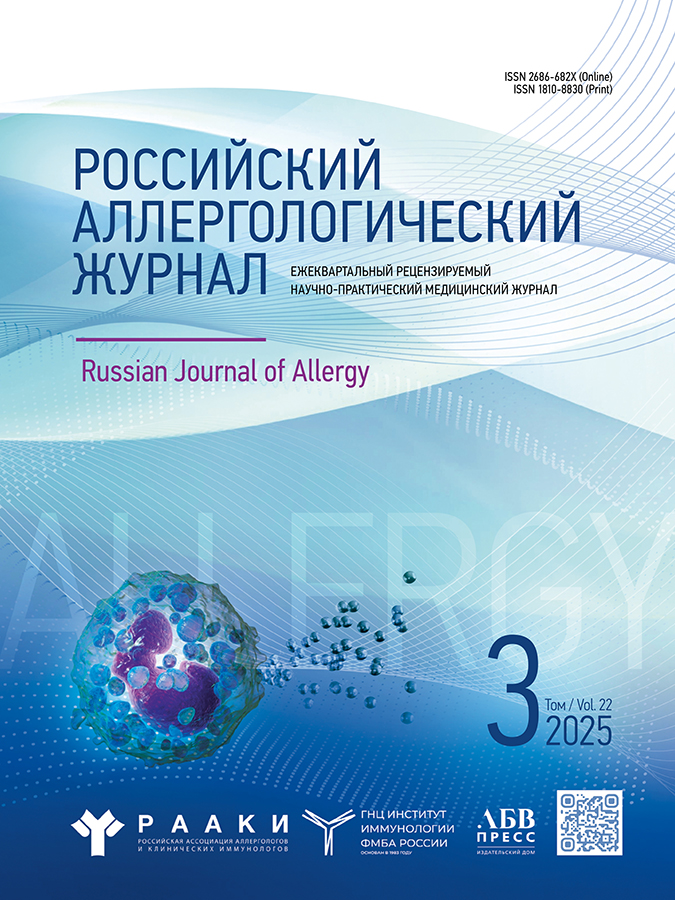EPITHELIAL CELLS EXPRESSING TLR-2 LEVEL AND NOSE MUCOSA BIOCENOSIS IN ALLERGIC RHINITIS PATIENTS
- Authors: Tyurin Y.A1,2, Sharifullina AA1, Mustafin IG2, Fassakhov RS3
-
Affiliations:
- Kazan Scientific Research Institute of Epidemiology and Microbiology
- Kazan State medical University
- Kazan State Medical Academy
- Issue: Vol 10, No 6 (2013)
- Pages: 20-24
- Section: Articles
- Submitted: 10.03.2020
- Published: 15.12.2013
- URL: https://rusalljournal.ru/raj/article/view/617
- DOI: https://doi.org/10.36691/RJA617
- ID: 617
Cite item
Abstract
Full Text
About the authors
Yu A Tyurin
Kazan Scientific Research Institute of Epidemiology and Microbiology; Kazan State medical University
Email: immunolab@yandex.ru
Russia
A A Sharifullina
Kazan Scientific Research Institute of Epidemiology and MicrobiologyRussia
I G Mustafin
Kazan State medical UniversityRussia
R S Fassakhov
Kazan State Medical AcademyRussia
References
- Ильина И.И. Аллергический ринит. Consilium medicum. 2000, № 2, с. 338-334.
- Шарифуллина А.А., Баязитова Л.Т., Клыкова Т. В. и соавт. Микрофлора полости носа у больных аллергическим ринитом. Нижегородский медицинский журнал. здравоохранение Приволжского федерального округа. 2004. Приложение, с. 56.
- Шарифуллина А.А. Сравнительная характеристика микробного биоценоза полости носа у здоровых и больных аллергическим ринитом детей. Мед. иммунол. 2006, № 2-3, с. 214.
- Караулов А.В., Алешкин В.А., Воропаева Е.А. и соавт. Показатели колонизационной резистентности слизистых ротоглотки как объективные критерии мукозального иммунитета при бронхитах у детей. Иммунология. 2012, № 5, с. 255-259.
- Метельская В. А., Алешкин В.А., Воропаева Е.А. и соавт. Колонизационная резистентность и иммунологическая реактивность слизистых ротоглотки у детей в норме и при бронхолегочных заболеваниях. вест. РАМН. 2010, № 7, с. 10-15.
- Hussein Y.M., Awad H.A., Shalaby S.M. et al. Toll-like receptor 2 and Toll-like receptor 4 polymorphisms and susceptibility to asthma and allergic rhinitis: a case-control analysis. Cell. Immunol. 2012, v. 274 (1-2), p. 34-38.
- Zhang G., Candelaria P., Mäkelä J.M. et al. Disparity of innate immunity-related gene effects on asthma and allergy on Karelia. Pediatr. Allergy Immunol. 2011, v. 22 (6), p. 621-630.
- Newcombe R.G. Two-sided Confidence Intervals for the Single Proportion: Comparison of Seven Methods. Statistics in Medicine. 1998, v. 17, p. 57-72.
- Толстопятова М.А., Буслаева Г.А., Козлов И.Г. Роль рецепторов врожденного иммунитета в развитии инфекционной патологии у новорожденных детей. Педиатрия. 2009, № 1, с. 115-119.
- Zang J.P., Yang C.C., Changes Y. Changes and clinical significance of Toll-like receptor 2 and 4 expression in neonatal infections. Zhonghua Er Ke Za Zhi. 2007, v. 45, p. 130-133.
- Bartemes K.R, Hirohito Kita. Dynamic role of epithelial-derived cytokines in asthma. Clin. Immunol. 2012, v. 143, p. 222-235.
- Chung F. Anti-inflammatory cytokines in asthma and allergy: interleukin-10, interleukin-12, interferon-gamma. Mediators Inflamm. 2001, v. 10, p. 51-59.
- Klimatsidas M., Anastasiadis K., Foroulis C. et al. Elevated levels of anti-inflammatory IL-10 and pro-inflammatory IL-17 in malignant pleural effusions. J. Cardiothorac. Surg. 2012, v. 4, p. 104.
Supplementary files



